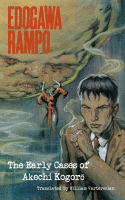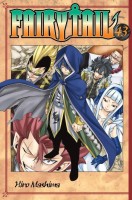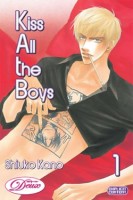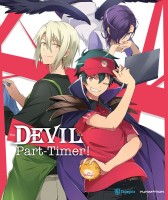My News and Reviews
Last week was another week with two reviews here at Experiments in Manga. My monthly horror manga review project is now underway, so I took a look at Setona Mizushiro’s After School Nightmare, Volume 1, which is a very intriguing start to the series. Next month I’ll start in on the in-depth reviews for Yuki Urushibara Mushishi and continue to alternate between the two series until the review project is completed. Last week I also reviewed The Early Cases of Akechi Kogorō by Edogawa Rampo, which I was very excited to read. The volume collects four of the earliest stories featuring Rampo’s great detective. And over at Manga Bookshelf proper, I and the rest of the Manga Bookshelf bloggers talked a little about the Manga the Year of 2014, noting some of our favorite things from the past year. Like I did last year, later this week I’ll also be posting my own list of notable releases from 2014.
I’m still extraordinarily busy at work as I settle into being the temporary boss of my unit for the next seven months or so, so I’ve been a bit preoccupied and haven’t had a chance to closely follow what’s going on in the mangasphere these days. However, I did still manage to catch a few interesting things to read online. Jason Thompson’s most recent House of 1000 Manga column focuses on Learn English with JoJo’s Bizarre Adventure, which I am now determined to track down. J. R. Brown has an introductory post to Boys in Skirts, her series of article and reviews focusing on otokonoko at Mode: Verbose. I also came across a fascinating post about the popularity of the Year 24 Group. I’m not familiar with the author or the blog, but it looks like it should have other promising manga articles as well.
Quick Takes
 Angel Sanctuary, Volumes 16-20 by Kaori Yuki. Here it is, the tumultuous conclusion to the epic Angel Sanctuary. By the end of the series, Yuki actually does manage to pull everything together in a way that mostly makes sense and proves that she actually can kill off a main character, something that I had my doubts about. I know a fair number of people who adore Angel Sanctuary, but while there were some things I really liked about the series, overall I found it pretty frustrating. Maybe I just wasn’t paying close enough attention, but more often than not I found Angel Sanctuary to be confusing and difficult to follow with a huge cast of characters, none of whom are exactly who they initially appear to be, and plot twist after plot twist. Granted, that did mean the series was consistently drama-filled. But with a little more editorial guidance, Angel Sanctuary could have been something phenomenal instead of just good. I did appreciate the manga’s core, however. Love is the driving force behind Angel Sanctuary. All of the characters are dealing with love in one way or another; it is the source of tremendous good as well as tremendous evil, but in the end it is shown to be a redemptive force.
Angel Sanctuary, Volumes 16-20 by Kaori Yuki. Here it is, the tumultuous conclusion to the epic Angel Sanctuary. By the end of the series, Yuki actually does manage to pull everything together in a way that mostly makes sense and proves that she actually can kill off a main character, something that I had my doubts about. I know a fair number of people who adore Angel Sanctuary, but while there were some things I really liked about the series, overall I found it pretty frustrating. Maybe I just wasn’t paying close enough attention, but more often than not I found Angel Sanctuary to be confusing and difficult to follow with a huge cast of characters, none of whom are exactly who they initially appear to be, and plot twist after plot twist. Granted, that did mean the series was consistently drama-filled. But with a little more editorial guidance, Angel Sanctuary could have been something phenomenal instead of just good. I did appreciate the manga’s core, however. Love is the driving force behind Angel Sanctuary. All of the characters are dealing with love in one way or another; it is the source of tremendous good as well as tremendous evil, but in the end it is shown to be a redemptive force.
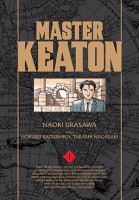 Master Keaton, Volume 1 written by Hokusei Katsushika and Takashi Nagasaki and illustrated by Naoki Urasawa. One of the many reasons that I became so enamored with manga was thanks to Urasawa’s series Pluto, so I’m always curious and excited when a new work of his is licensed in English. Admittedly, Master Keaton, while newly translated, is one of Urasawa’s older collaborations that began in the late 1980s. The titular Keaton (technically Hiraga-Keaton) is a half-Japanese, half-English archaeology professor who works as an insurance investigator on the side. He also used to be a member of the British Army’s Special Air Service, which adds survival skills and combat experience to his already impressive and eclectic set of talents. I enjoyed the first volume of Master Keaton. The manga has a nice mix of action and adventure, mystery and detective work, and even a bit of family drama. Occasionally it can be a little heavy on politics and history which interrupts the series’ pacing, but generally the slower parts are interesting, too. It’s also worth mentioning that the book design and production quality of Viz’s release of Master Keaton is particularly nice.
Master Keaton, Volume 1 written by Hokusei Katsushika and Takashi Nagasaki and illustrated by Naoki Urasawa. One of the many reasons that I became so enamored with manga was thanks to Urasawa’s series Pluto, so I’m always curious and excited when a new work of his is licensed in English. Admittedly, Master Keaton, while newly translated, is one of Urasawa’s older collaborations that began in the late 1980s. The titular Keaton (technically Hiraga-Keaton) is a half-Japanese, half-English archaeology professor who works as an insurance investigator on the side. He also used to be a member of the British Army’s Special Air Service, which adds survival skills and combat experience to his already impressive and eclectic set of talents. I enjoyed the first volume of Master Keaton. The manga has a nice mix of action and adventure, mystery and detective work, and even a bit of family drama. Occasionally it can be a little heavy on politics and history which interrupts the series’ pacing, but generally the slower parts are interesting, too. It’s also worth mentioning that the book design and production quality of Viz’s release of Master Keaton is particularly nice.
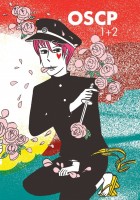 Open Spaces and Closed Places, Volumes 1-6 by Saicoink. I don’t remember exactly when or how I first heard about the mini-comic series Open Spaces and Closed Places, but it was recently brought to my attention again when Saicoink released the sixth and final volume. I finally got around to reading the series, and I absolutely loved it. Jirou is the boss of the delinquents at his school. When he isn’t busy getting into fights, he’s pining for Oscar, the president of the student council. Oscar likes Jirou, too, but for various reasons doesn’t feel he can accept his love, and so spends much of his time teasing the other boy instead. It’s a delightful relationship, both adorable and sad at the same time. Soon after Open Spaces and Closed Places begins, fantastical elements are introduced and the series becomes more and more surreal as it goes, culminating in a spectacular dream sequence. Saicoink specifically mentions drawing inspiration from Suehiro Maruo and Usamaru Furuya. While their influence can be seen in Open Spaces and Closed Places, the series isn’t as grotesque or as graphic as some of their works, though its humor is still accompanied by some amount darkness and tragedy. It’s a sinister, strange, and wonderful series.
Open Spaces and Closed Places, Volumes 1-6 by Saicoink. I don’t remember exactly when or how I first heard about the mini-comic series Open Spaces and Closed Places, but it was recently brought to my attention again when Saicoink released the sixth and final volume. I finally got around to reading the series, and I absolutely loved it. Jirou is the boss of the delinquents at his school. When he isn’t busy getting into fights, he’s pining for Oscar, the president of the student council. Oscar likes Jirou, too, but for various reasons doesn’t feel he can accept his love, and so spends much of his time teasing the other boy instead. It’s a delightful relationship, both adorable and sad at the same time. Soon after Open Spaces and Closed Places begins, fantastical elements are introduced and the series becomes more and more surreal as it goes, culminating in a spectacular dream sequence. Saicoink specifically mentions drawing inspiration from Suehiro Maruo and Usamaru Furuya. While their influence can be seen in Open Spaces and Closed Places, the series isn’t as grotesque or as graphic as some of their works, though its humor is still accompanied by some amount darkness and tragedy. It’s a sinister, strange, and wonderful series.
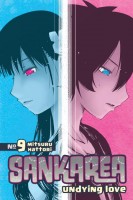 Sankarea: Undying Love, Volume 9 by Mitsuru Hattori. Sometimes Sankarea is all about its horror, sometimes it’s all about its peculiar romantic comedy, and sometimes it manages to be about both. The ninth volume is generally successful in balancing the series’ two opposing aspects, though the comedy has definitely taken a turn for the serious. Hattori does still find plenty of opportunities to add a bit of fanservice to the manga, this time mostly in the form of dressing Rea up in a variety of revealing costumes and outfits, often for no better reason than she looks cute in them. But even with those largely unnecessary diversions, the plot does continue to move along nicely in the ninth volume. Chihiro and most of the rest of his group have made their escape from ZoMA and return to Japan. Rea is suffering from amnesia though and doesn’t remember Chihiro or their relationship. Often I’m annoyed by the memory loss trope in manga—frequently it’s the result of bad or lazy writing—but for the most part it actually works pretty well in Sankarea. I still like the quirkiness of the characters in Sankarea, but Bub the undead cat remains my favorite by far.
Sankarea: Undying Love, Volume 9 by Mitsuru Hattori. Sometimes Sankarea is all about its horror, sometimes it’s all about its peculiar romantic comedy, and sometimes it manages to be about both. The ninth volume is generally successful in balancing the series’ two opposing aspects, though the comedy has definitely taken a turn for the serious. Hattori does still find plenty of opportunities to add a bit of fanservice to the manga, this time mostly in the form of dressing Rea up in a variety of revealing costumes and outfits, often for no better reason than she looks cute in them. But even with those largely unnecessary diversions, the plot does continue to move along nicely in the ninth volume. Chihiro and most of the rest of his group have made their escape from ZoMA and return to Japan. Rea is suffering from amnesia though and doesn’t remember Chihiro or their relationship. Often I’m annoyed by the memory loss trope in manga—frequently it’s the result of bad or lazy writing—but for the most part it actually works pretty well in Sankarea. I still like the quirkiness of the characters in Sankarea, but Bub the undead cat remains my favorite by far.

